
SET EXPO 2017 - What was discussed?
SET Expo 2017 - What was discussed?
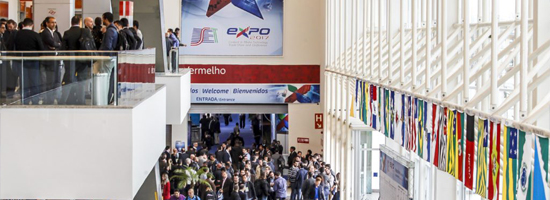
From August 21 to August 24, SET EXPO 2017 presented and discussed technical innovations, regulations and new products in the audiovisual market, covering the entire production chain, from creation through to distribution. At the Congress, the participants discussed how to manage, produce, transmit and distribute multimedia electronic content while debating the current standards and regulations, with the emphasis on the current and future scenario for telecommunications. At the Trade Show, the main domestic and international manufacturers showcased their products to an audience representing the entire audiovisual and broadcasting production chain.
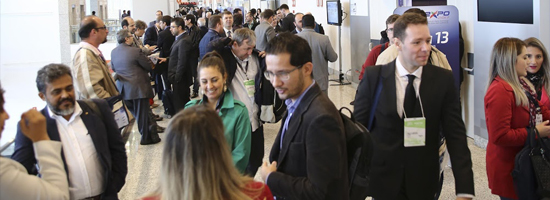
There were many points discussed this year, and the 14 main ones were:
New TV standards, UHD formats and next steps
Kenizhi Murayama, NHK senior researcher, gave an overview of the digital broadcasting service in Japan and the 8K signal, tested on major broadcasts in the country since 2015 (in that year, there was a transmission test, in 2016 a new test was made during the Olympic Games in Rio, and the next one will take place during the World Cup in Russia in 2018, and finally the model of transmission to be adopted for the Tokyo Olympics in 2020). NHK began testing the system on domestic broadcasts last year. And the test of transmission done in Rio last year, in partnership with TV Globo, is the same that we implemented later in Japan.
Another good news is about ATSC 3.0, the groundbreaking standard of terrestrial television broadcasting, that is almost ready, which increases the channel capacity by 30% with improvements in audio and video quality, with multiple audio and video streams, custom content, a wider choice of consumer and transmitter choices, internet interactivity, advanced emergencies and new alerts accessibility features.
There was also discussion about the next steps of the TV based on mobile devices, looking at the total view time for videos growing with the massive growth of views on mobile devices.
Another discussion is about new technologies and trends that could help reduce the compression rates for transmission, on the support of different formats of HDR and transmission networks for the distribution of 4K/8K signals.
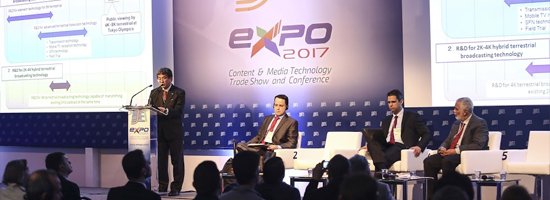
Digital revolution and the new doors that are opening
According to the presentation of the Google executive, Fábio Coelho, the TV set is still the main screen, but its use has stopped growing. By 2015, in the United States, for example, 60% of millennials (born between the mid-1980s and the 2000s) still preferred television, but 26% opted for a computer screen. Mobile gadgets were 14% of preference. By comparison, TV is the choice of 79% of the generation X (born between 1960 and the early 1980s), and 86% of baby boomers born during the post-World War II and 1960s.
Advertising revenue reflects this change and therefore "we should think about video rather than television," Coelho reflected, "and our role is precisely to help companies generate value in the digital economy. The human being remains the same, but today we have very different expectations. The consumer is much more impatient and lazy, and companies need to understand what role they play in reducing that friction." As examples within the company, the executive has shown that Brazil is one of the top five Google countries in the use of platforms and that Waze has Sao Paulo as the main city.
Also, Liliana Nakonechnyi, the president of SET - organizing entity of SET EXPO, analyzed the Brazilian trajectory of the analog TV system until the implementation of the Brazilian digital TV technology (ISDB-TB), created from the Japanese standard. She also said: "We have had a leading role in this movement, but the technology also throws uncertainties on how to adopt tools like IP for video, cloud usage, and other changes."
Masahiko Tominaga, representing Japan's contribution to the deployment of digital TV in Brazil, believes that "success in shutting down the analogue signal in cities as big as São Paulo is an important motivation for other cities in Brazil. Last year, was the celebration of 10 years of ISDB-TB, in 2017 El Salvador also joined this group of 19 countries. This signal pattern was adopted in almost all the countries of South America and Central America in Guatemala, Honduras, Nicaragua and Costa Rica.
More flexibility and scalability: IP in broadcasting
The IP expert at Grass Valley, Robert Erickson, hosted the IP Production: From Theory to Practice workshop, which took place on the afternoon of last Monday, August 21, during the SET Congress. According to the executive, the industry is changing and new forms of consumption are demanding adjustments in the production and distribution chain and business models.
"The means of distribution are very diverse and each requires an image resolution," he says, noting that removing the physical interfaces of the equation allows the construction of more modern solutions that meet modern workflow requirements.
IP can reduce operating costs and provides gains in scalability, flexibility and upgradeability, and broadcast industry is headed for that. And this change will take a while.
Claudio Szabas, the company's project manager, followed a demonstration of Grass Valley IP solutions, noting that there are no changes to the operator, which uses the panel that is already used, and can direct the camera, the IPG and share the multiviewer.
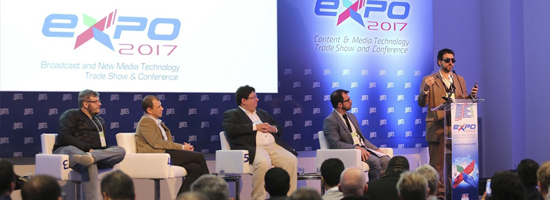
Virtual reality: closer than you think
Many still do not know, and believe that virtual reality is a fad, and others believe it is a trend. Marcos Alves, director of ventures of the Canadian YDreams Global; Renato Citrini, Senior Product Manager, Samsung Mobile Devices Division; and Ricardo Laganaro, director of O2 Filmes, were invited to discuss the issue in the panel on Innovation and Disruptive Technologies that took place on the afternoon of Monday, August 21, during the SET Congress. For them, the cheapening of the equipment, the improvement in the quality of connection to the internet and also of the production must help the virtual reality to reach the masses.
According to Citrini, Samsung has worked to perfect and at the same time cheapen its line of glasses for VR. The latest version of Gear VR comes with a control, the camera is smaller, has more functionality, such as the ability to do live streaming, and is cheaper. "Things evolve at an amazing speed. Anyone can be a virtual reality producer and consumer." The manufacturer has made some bets to increase the consumption of the technology, like transmission of fights of UFC with cameras positioned in the border of the octagon or transmission of shows, one of the most recent one was of the band Coldplay in the United States. Locally there are also some initiatives to increase the offer in the Samsung VR content store.
For Alves, the great opportunities for the diffusion of the virtual reality are the independent games, the arcades of virtual reality, the platforms of distribution and capture of contents, like the NextVR, the possibilities in the areas of education, health and in the industry of the sex. As a content producer, Laganaro is also committed to the development of technology and fast consumer acceptance. "I prefer to speak in immersive narratives," says the director, remembering that those who produce content need to start thinking beyond the flat screen, to learn a new way of operating in the audiovisual, because to produce using virtual reality is a cyclical process involving content, technology, production, narrative and language.
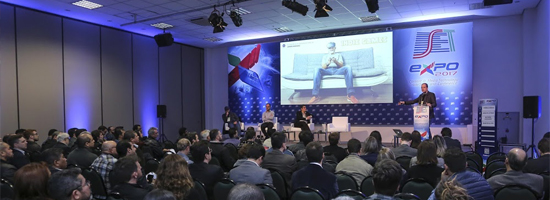
IoT: digital security
Brazil is the fourth country in terms of DDoS-type cyber attacks, in which servers are not properly invaded, but are prevented from functioning. The number is a good index to assess the importance of security for content production and broadcasting companies, an issue explored by experts during the first day of the SET EXPO 2017 Technology Congress.
One of the big doors to the threats are Internet-connected devices, such as smart TVs and mobile phones, which are expected to add up to 20 billion handsets by 2020, according to TV Globo's information security expert Leandro Valente. Often the danger is easy to avoid, as many devices such as security cameras and internet routers have the default password maintained by users. The key is to change the settings at the time of installation. In a universe in which every audiovisual work is available mainly in digital media, companies must also be attentive to their internal processes. 9 out of 10 companies in the country suffer from cybersecurity violations, said Tácito Leite, director of T-Risk. "The Internet of Things is the new frontier for cyber-extortion, but companies do not consider security as a fundamental requirement."
Startups: new technologies and opportunities
With gaps for new companies, new entrepreneurs, the market for audiovisual innovation can be a great opportunity for growth. Most audiovisual productions are still concentrated in traditional media, but lower-cost productions are gaining ground, as the public's attention is drawing.
Today it is possible to capture aerial images at a lower cost through drones, cameras and equipment are more accessible. For example, 360-degree content and integration with OTTs make content profitable, showing that a good idea is enough to become a big business.
"More than money, startups need business opportunities," said Edson Mackeenzy, head of the SET Innovation Zone, a pavilion designed to give visibility to startups working in the audiovisual industry during SET EXPO. "Companies need to invest and believe in national technology."
Also, the president of Abragames and CEO of Webcore Games, Fernando Chamis, addressed the gaming market in Brazil and the world, and gave examples of games made in the country that today are successful worldwide, such as Horizon Chase. "It's a market that has been growing, for a long time, 10% a year," he said. In Latin America, Brazil is the market that makes the most, although the number is still low, due to cost and piracy.
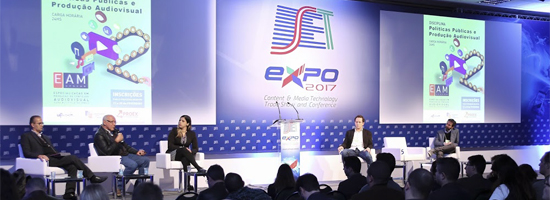
SET EXPO 2017: Business and optimism
The mission of SET EXPO 2017 is to stimulate discussions and offer the solutions to foster the changes of the industry in Brazil towards digital convergence. And the expectation of the exhibitors is that the event move more than $ 40 million in business.
The main point was the convergence of Telecom companies, pay-TV operators, large and independent producers, the advertising market and even youtubers.
In addition, the video market is diversifying and presents several options, highlighting 4K, HDR, IP technologies, all new workflows and formats.
The Technology Congress brought together 1400 congress members in four days of panels with experts from companies such as TV Globo, O2 Filmes, Dolby Laboratories, SBT, RecordTV, Ericsson, Samsung, and more than 40 entities, such as SEBRAE - Brazilian Service of Support to Micro and Small Enterprises; ABRATEL - Brazilian Radio and Television Association; ABERT - Brazilian Association of Radio and Television Broadcasters; AESP - Association of Radio and Television Broadcasters of the State of São Paulo, among others.
Cloud Storage trend
Digital transformation in the industry has changed the way suppliers and broadcasters think and market their experiences and products.
The demand for OTT video services is growing, and since then the budget for cloud services has been following this trend. One of the concerns when it comes to the subject is the security issue.
There is no doubt that the cloud will continue to be a storage trend and that the market dynamics have brought several issues for the companies that use the service, since there must be agile, fast and economical systems. It is worth mentioning that the use of the cloud is not only for end users, but for several sectors, such as the journalistic, in social networks, in post-production.
UHD and Digital Cinema
The innovations and disruptive technologies point to ongoing transformations that encompass audiovisual productions in multiple screens and windows. In the stations there is the expectation of the arrival of the 4K, something that already is reality in the cinema.
In addition, there are many goals in a fully digital environment, especially in post-production, in process planning, always ensuring maximum quality.
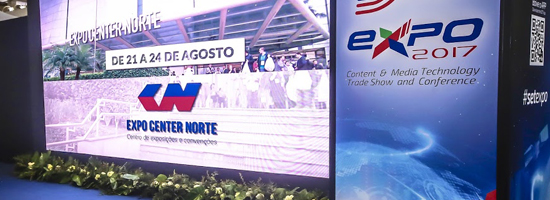
IP and Satellites
Satellite industry is going through a very special moment, not only from an application point of view, but also from a technology standpoint. And consumer behavior dictates the need for new IP technologies.
With the IP universe, new applications will have room for video and audio. The trend is that satellite companies become IP video companies, even if it is a conservative market, changes are expected to occur more and more.
Switch-off: Lessons and what’s around
The switch-off in Brazil has worked well and every city that enters the digital age there is a new learning. The instruction of the population and the installation of adapters has had a positive return, even if at the beginning they had a concern with the distributed kits.
One of the concerns was the audience issue, whether the transition would cause the audience to fall due to signal change, but studies showed that there were no changes.
In addition to the concerns, it is relevant to say that the market has grown as people began investing in new TVs.
Digital era: Real experiences and audience
Engaging consumers with experiences is the best way to ensure audience in the entertainment market.
The phrase that sums up the new consumer mode of media is: Unique experience. The idea is to bring people on different platforms to the same point, in order to establish a relationship, loyalty to the client using the convenience of digital and preserving the best in the face-to-face experience.
The trend can be seen through data, according to research conducted by Marcela Doria, director of research for Twitter in Latin America, 9 out of 10 people declare that the smartphone is the most used device to access the Internet, and 7 out of 10 multiteels are declared. That is, many people use the smartphones while watching television, for example. In Brazil alone, more than 1 million tweets per day are related to TV. Twitter today is the smallest distance between the viewer and the content, and the tool is able to contribute about 13% to the audience of a show, with even greater force in live events such as the Oscars.
OTT in Brazil and worldwide
According to the research presented by Salustiano Fagundes, founder of HIRIX Engenharia de Sistemas and CEO of HXD Smart Solutions, the OTT market will reach US$ 64 billion worldwide in 2021, with US $ 3.59 billion being only between Brazil and Mexico, who should lead Latin America and occupy, respectively, the fourth and fifth global posts. As for the survey conducted in the United States, consumers spend 45% more time choosing what to watch on VOD services than looking for a program to watch on linear TV, and 4K video streaming is growing, with Netflix and Amazon broadcasting on that quality.
Meanwhile, NHK's senior research engineer, Masaru Takechi, who works to deploy and harmonize the Hybridcast, a second-screen and VOD/streaming service said that in Japan, more than five million people use the system, with flexible selection of content, generating targeted advertising and a similar content relation.
The director of digital platforms Globo.com, Marcello Azambuja, talked about the live streaming company. The first was the Big Brother Brazil and in 2003, the first OTT of Brazil was launched, the Globo Media Center, and in 2005 it had the broadcast of the NBA final. In 2010, at the World Cup, the site made the broadcast for the first time in HD. And in 2014 had the first multi-camera live stream. He complements saying about the availability of 4K content available on Globo Play.
Migration of AM radios
Radio is one of the most accessible and popular media worldwide, and the migration of AM to FM broadcasters has moved companies and regulators in Brazil.
RBS project manager, Cauê Franzon, showed that conventional radio is still 58% of the audience between 10am and 11am, and 15% of cellphone listeners between 2pm and 3pm. Only 5% listen through the computer between 2pm and 3pm. The data compiled by Ibope show that radio reaches 89% of people in the 13 metropolitan regions where the audience is measured, which is equivalent to 52 million people. The average time of the tuned is of 4h36, which shows a space of great growth in mobile devices.
The great effort needed to accommodate the stations that will migrate from AM to FM is much discussed, and we are likely to see more discussions about it, to make the switch as smooth as the switch-off is on TV in Brazil.
If you want to see how the fair was, visit the link.
In this video you can view some of SET Expo 2017:
We would like to thank Marcel Almeida for writing for us.
More info you can find on his LinkedIn: br.linkedin.com/in/marcelmg77/en or follow him on Twitter @marcelmg77
Like us if you want on Facebook, follow us on Twitter and Subscribe to our YouTube channel.
mentioned:
SET EXPO 2017 : Website - facebook - Twitter - YouTube
SET : Website